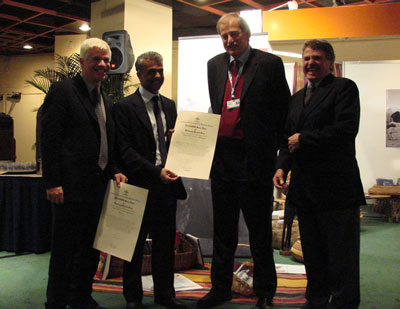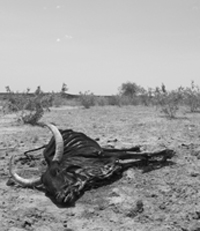Public-private partnership makes major step towards improving livestock health and reducing poverty.
The devastating effects of East Coast fever on the livelihoods of small-scale farmers may one day be a thing of the past as a team of international scientists moves closer towards the development of a vaccine.
“East Coast fever is an intractable problem that ravages cattle of the poor in Africa. The good news is that this can be solved by high-tech science and technological innovations, achievable through strategic partnerships’’. Evans Taracha – ILRI East Coast Fever Vaccine Project Leader
Every year, East Coast fever destroys the small farmer’s dream of escaping poverty in Africa. Killing more than a million cattle and costing some $200 million annually, this tick-borne disease rages across a dozen countries in eastern and central Africa. Now, an international team of scientists has taken the first major step toward a vaccine to prevent East Coast fever. Their work, published in the February 13-17 early online edition of the Proceedings of the National Academy of Sciences (PNAS), shows how genomics can generate pivotal new vaccines.
In the study, scientists from five institutions, including the International Livestock Research Institute (ILRI) and The Institute for Genomic Research (TIGR), identify five vaccine targets, or candidate proteins that could form the basis for an East Coast fever subunit vaccine. Based on combined bioinformatics analyses and lab tests, these proteins appear to provide a protective immune response to the disease. “This initiative took just three years, after many years of scientists trying other methods,” remarks Vishvanath Nene, former ILRI staff member, a study author and molecular biologist at TIGR. “It’s a huge jump forward.”
To make the jump, researchers used the genome sequence of the parasite responsible for East Coast fever. A tick-borne parasite, Theileria parva, causes the disease. When ticks infected with T. parva bite cattle, they transmit the parasite, launching the disease that typically kills cattle within a month. In July, 2005, TIGR led a research team that published T. parva’s genome sequence, representing roughly 4,000 genes, in Science.
In the current study, Nene, along with Malcolm Gardner and Claire Fraser-Liggett, also of TIGR, relied on known biology to search T. parva’s genome for potential vaccine proteins. First, scientists know that immunity to the parasite, and thus East Coast fever, emerges from immune system cells known as killer T cells. Second, they know that T. parva is an intracellular pathogen–it infects and secretes proteins inside cattle white blood cells, which become malignant. The white blood cell then unwittingly passes small fragments of the secreted parasitic proteins associated with a certain type if its own proteins along to its cell surface. And this is where a vaccine could come in: A vaccine made of the T. parva proteins found on the surface of host cells should trigger an immune response in cattle. Vaccinated cattle would then be protected from the parasite.
To find potential vaccine antigens, the TIGR researchers scanned T. parva’s entire genome for genes that make secreted proteins. In particular, they searched for genes that make a “secretion signal,” a telltale peptide sequence found at the start of secreted proteins. Sure enough, the scientists found some 400 T. parva genes containing the secretion signal. This set of genes provided a starting pool of candidate proteins. Based on further tests, the study’s research team, led by ILRI of Nairobi, Kenya, cloned 55 candidate antigen genes and screened those genes for response by killer T cells taken from cattle immune to East Coast fever. To complement TIGR’s gene selection strategy, ILRI also incorporated a random screen of T. parva DNA for vaccine candidates.
In total, the team found five candidate vaccine antigens. In lab tests, these antigens triggered a response from cattle immune killer T cells. Going a further step further, the scientists inoculated cattle with these antigens and then gave the cattle a potentially lethal dose of T. parva. When compared with control animals, vaccinated cattle showed significantly stronger immune response to the parasite.
“This study is a true milestone,” says Fraser-Liggett, president of TIGR. “It’s one of the first to take advantage of genomic technologies and build a test vaccine using immune killer T cells as a screening reagent.” In addition to TIGR and ILRI, the research team included scientists from: the Ludwig Institute for Cancer Research in Brussels; the Wellcome Trust Center for Human Genetics in Oxford; Sanofi Pasteur in Toronto; the University of Edinburgh; and Merial SAS, an international animal health company. ILRI and Merial have partnered to develop a vaccine against East Coast fever.
By using genomics to understand and fight T. parva, scientists may make advances against related parasites that cause malaria, tuberculosis, and other diseases in which killer T cells also play a role in immunity. What’s more, because T. parva launches a cancer-like illness inside the white blood cells of cattle, it may provide a model system for understanding the mechanics of cancer biology.
But for Nene, who was born in Kenya and worked at ILRI for 15 years before coming to TIGR in 2001, the march against East Coast fever is significant reward, itself. “This disease takes an enormous toll on the local society and economy of rural areas across eastern and central Africa, including Maasai and other pastoral communities,” he says. In particular, East Coast fever kills cattle kept by families trying to rise out of poverty. If researchers are successful, Nene notes, the entire region will have new reason to hope for a better life. Evans Taracha, ILRI project leader, also highlights the importance of strategic research partnerships to overcome this and similar diseases.
TIGR’s portion of the PNAS study was funded independently by TIGR and by sub-contract from the Animal Health Program of the United Kingdom Department for International Development, with previous contributions from J. Craig Venter and the ILRI for the T. parva genome project.





























